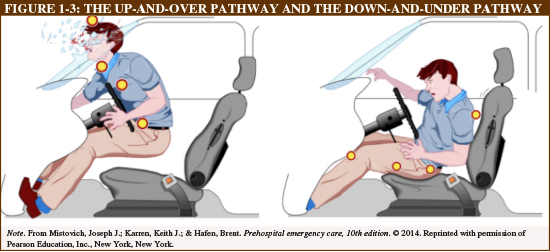Head-on Motor Vehicle Collisions
Vehicle collisions will typically cause blunt trauma. Compression is the main cause of injury. The extent of these will depend on the force applied, the length of time the body region is compressed and the area of the body affected by this compression. Other factors affecting the extent of injuries are the type of collision, the position of the occupant inside the vehicle and the use of passive or active restraint systems.
Three Impacts
When a motor vehicle is involved in a collision three impacts must be taken into consideration:
1- The vehicle versus the object
2- The victim versus the inside of the car
3- The organs versus the body cavity
(A fourth impact can also be mentioned as loose objects inside the car itself can also impact the body and cause harm)
Predictable injury patterns
Head-on collisions occur when a vehicle collides with another vehicle or still object producing a frontal impact collision. As momentum continues inside the vehicle, the second impact (victim vs inside of car) will occur. Occupants with a restraint system, may end up hitting the dashboard, steering column and restraint system causing the force of impact to be absorbed in diverse regions. Patients who are part of head-on collisions who don’t wear restraints systems may travel up and over the steering column or down and under it. This phenomenon can be described by Newton’s first law of motion stating that “an object at rest stays at rest and an object in motion stays in motion with the same speed and in the same direction unless acted upon by an unbalanced force”(1). The signs pertaining to where the occupant collides with the inside of the vehicle will be different depending on the pathway. Thus, the direction in which organs are projected in the body cavity will also cause differing injuries. It is to be noted that as the crash occurs, the dashboard and steering column may end up compressed towards the patient making a closer impact and leading to further damage.
Up and Over Pathway
The up and over pathway is usually more frequent in tall individuals who do not wear their seat belts. The body is propelled up and forward above the steering column causing the thorax and head to absorb the most of the impact. The abdomen may also collide with the steering column causing additional injuries.
-
Rib fractures
-
Ruptured diaphragm
-
Hemo-pneumothorax
-
Pulmonary contusions
-
Cardiac contusion
-
Myocardial rupture
-
Vascular tearing such as aortic rupture, inferior vena cava rupture
-
Kidney, Liver, Spleen damage to organs themselves or to vascular attachments
-
Ruptured diaphragm
-
Lumbar vertebrae fractures
-
Cervical flexion, axial loading and hyperextension of the cervical vertebrae
-
Head trauma ( subdural / epidural hematoma, contusion, oedema, etc.)
-
Corneal abrasions / friction burns caused by airbag deployment
Down and Under Pathway
The second pathway they may take is down and under the steering column causing the impact to be absorbed by the upper legs and knees initially, causing further predictable patterns of injuries (mentioned below). Next, the body will rotate forward causing the thorax, face and neck to collide with the dashboard or steering column producing similar injuries to that of the up and over pathway (seen above).
-
Knee dislocation
-
Patella fracture
-
Femoral fracture
-
Fracture / posterior dislocation of the hip
-
Acetabulum fracture
-
Vascular tears due to impact / fractures causing hemorrhage
(1) http://www.physicsclassroom.com/class/newtlaws/Lesson-1/Newton-s-First-Law
High risk vs low risk collisions
-
Vehicle crashes with major intrusions into the vehicle cabin
-
Ejection
-
Death of occupant in vehicle
-
Patient presenting with multi-system injuries
- Bull’s eye pattern on windshield indicating the force of impact was transferred to the skull and upper spine
References
Lachaine, C. (2015). Protocoles d'Intervention à l'Usage des Techniciens Ambulanciers Paramédics . (Québec) Retrieved September 22, 2017, from PICTAP: https://www.urgences-sante.qc.ca/wp-content/uploads/2016/05/0-PICTAP- 2015_Version-Officielle_MD_2016-05-17.pdf
Newton's First Law. (n.d.). Retrieved September 23, 2017, from http://www.physicsclassroom.com/class/newtlaws/Lesson-1/Newton-s-First-Law
Sanders, M. J. (2015). Mosbys paramedic textbook (4th ed.). St-Louis, MI: Jones & Bartlett Learning.




